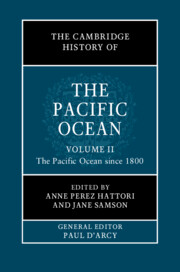Book contents
- The Cambridge History of the Pacific Ocean
- The Cambridge History of the Pacific Ocean
- The Cambridge History of the Pacific Ocean
- Copyright page
- Contents
- Figures
- Tables
- Contributors to Volume II
- Frontispiece
- General Editor’s Introduction
- Preface to Volume II
- Part VII Rethinking the Pacific
- 32 Climate Change, Rising Seas, and Endangered Island Nations
- 33 Authority, Identity, and Place in the Pacific Ocean and Its Hinterlands, c. 1200 to c. 2000
- 34 Europe’s Other? Academic Discourse on the Pacific as a Cultural Space
- 35 The Phantom Empire
- 36 Blue Continent to Blue Pacific
- Part VIII Approaches, Sources, and Subaltern Histories of the Modern Pacific
- Part IX Culture Contact and the Impact of Pre-colonial European Influences
- Part X The Colonial Era in the Pacific
- Part XI The Pacific Century?
- Part XII Pacific Futures
- References to Volume II
- Index
35 - The Phantom Empire
Japan in Oceania and Oceania in Japan from the 1890s Onward
from Part VII - Rethinking the Pacific
Published online by Cambridge University Press: 11 November 2022
- The Cambridge History of the Pacific Ocean
- The Cambridge History of the Pacific Ocean
- The Cambridge History of the Pacific Ocean
- Copyright page
- Contents
- Figures
- Tables
- Contributors to Volume II
- Frontispiece
- General Editor’s Introduction
- Preface to Volume II
- Part VII Rethinking the Pacific
- 32 Climate Change, Rising Seas, and Endangered Island Nations
- 33 Authority, Identity, and Place in the Pacific Ocean and Its Hinterlands, c. 1200 to c. 2000
- 34 Europe’s Other? Academic Discourse on the Pacific as a Cultural Space
- 35 The Phantom Empire
- 36 Blue Continent to Blue Pacific
- Part VIII Approaches, Sources, and Subaltern Histories of the Modern Pacific
- Part IX Culture Contact and the Impact of Pre-colonial European Influences
- Part X The Colonial Era in the Pacific
- Part XI The Pacific Century?
- Part XII Pacific Futures
- References to Volume II
- Index
Summary
At some point in 1898, famed Japanese folklorist Yanagita Kunio2 was walking along the long, sandy beach of Iragonomisaki, Aichi Prefecture – not far from the site of the present-day Toyota car manufacturing factory – when he stumbled upon a dried coconut that had washed up in the surf. Fascinated by this and insistent that it proved Japanese connections to southern tropical islands via the Kuroshio (Pacific) Current,3 he mentioned his discovery to his friend, the poet Shimazaki Tōson, who would later memorialize the moment in the first lines (above) of his wistful poem, ‘Yashinomi’ (Coconut), written in 1901 and set to music by Ōnaka Toraji in 1936.
- Type
- Chapter
- Information
- The Cambridge History of the Pacific Ocean , pp. 98 - 131Publisher: Cambridge University PressPrint publication year: 2023

